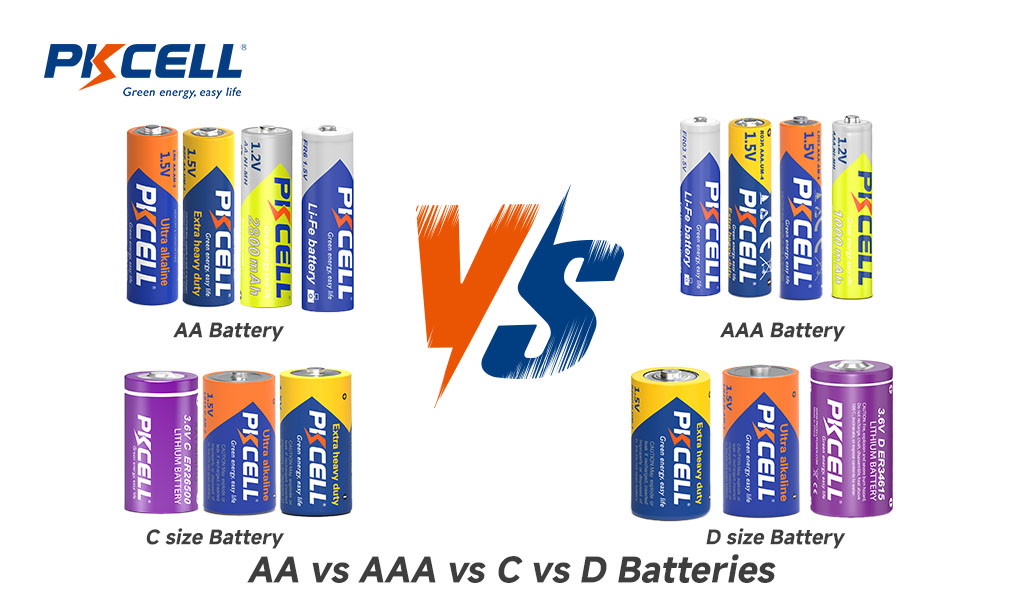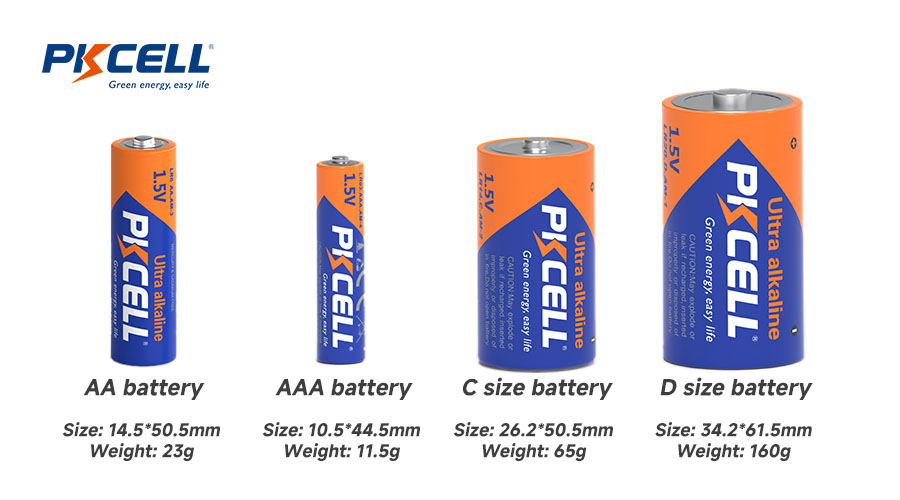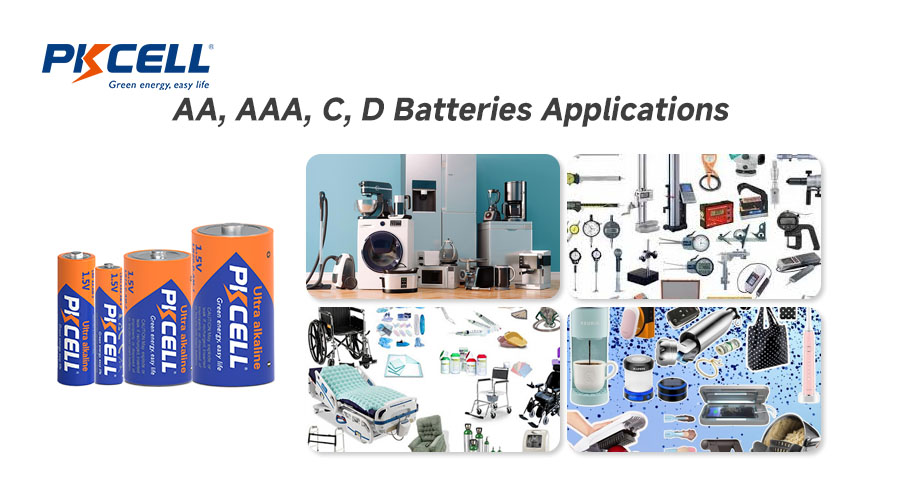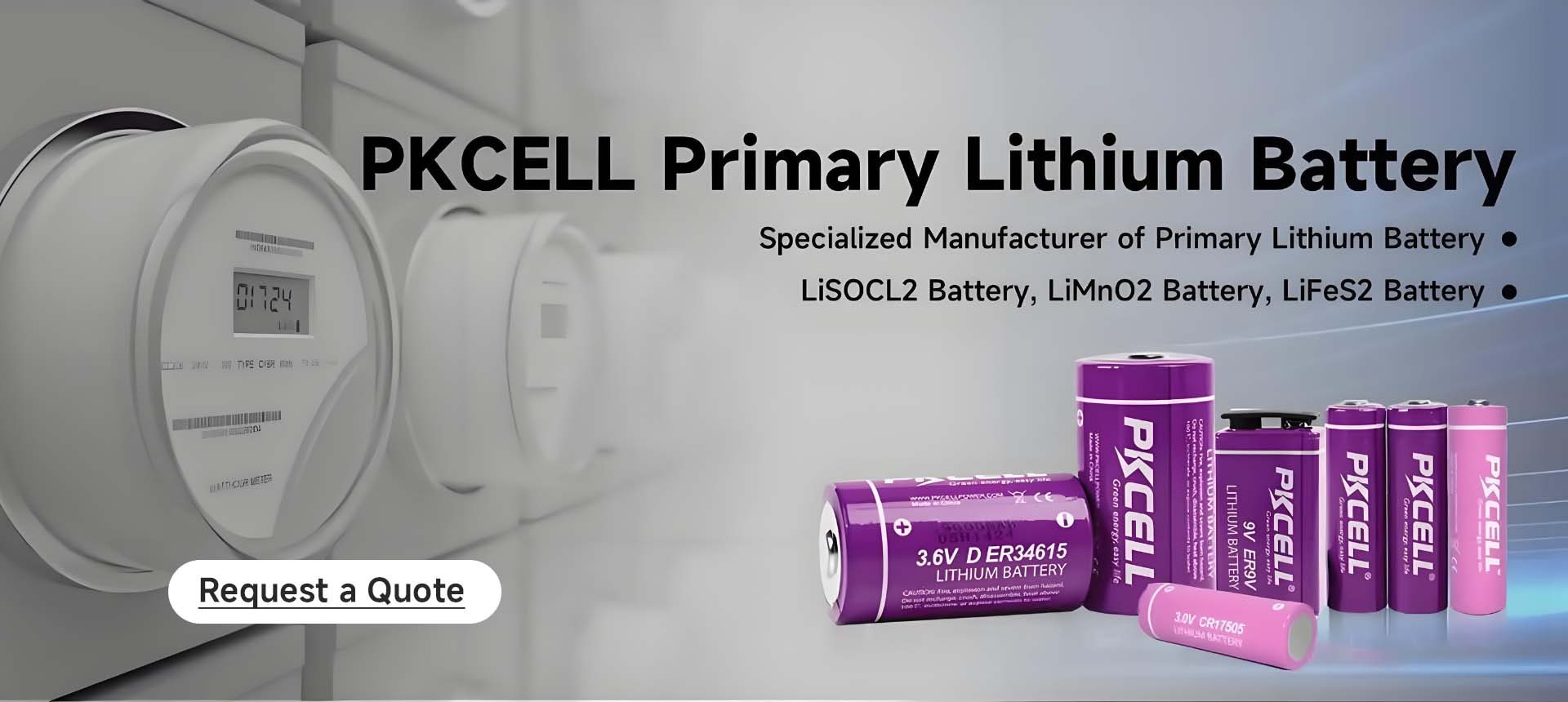Klíčové body
- Typy a velikosti baterií jsou důležitéBaterie AA, AAA, C a D se liší fyzickými rozměry, energetickou kapacitou a použitelností pro elektronická zařízení.
- Alkalické vs. dobíjecí baterieAlkalické baterie nabízejí pohodlí, zatímco NiMH a lithiové baterie přinášejí cenové a environmentální výhody.
- Trvanlivost a životnostVyšší energetická kapacita znamená delší výdrž baterie pro zařízení s vysokou spotřebou energie.
- Technické poznatkyKonzistence napětí, typy chemie a hmotnost vytvářejí jedinečné výhody pro každou velikost baterie.
Velikosti baterií: Vysvětlení AA, AAA, C a D
Nejjednodušší způsob, jak rozlišit jednotlivé typy baterií, je jejich velikost. Nejmenší jsou baterie typu AAA. Jsou dlouhé asi 44,5 mm a mají průměr 10,5 mm. Díky této malé velikosti jsou ideální pro malá zařízení. Baterie typu AA jsou o něco větší. Ty jsou dlouhé asi 50,5 mm a široké 14,5 mm, takže pojmou více energie.
Baterie typu C jsou ještě větší, s délkou 50 mm a šířkou 26,2 mm. Ty mají vyšší kapacitu. Největší jsou články typu D. Články typu D mají délku 61,5 mm a průměr 34,2 mm. Tyto baterie jsou nejvhodnější pro zařízení, která potřebují hodně energie.
Všechny tyto baterie – baterie typu AAA, AA baterie a články D – mají stejný kulatý tvar. Je to záměrné. Díky tomu se bez problémů vejdou do většiny zařízení.
Hmotnost a ovladatelnost: Praktické rozdíly
Hmotnost baterie ovlivňuje nejen to, jak snadno se zařízení přenáší, ale také jak dlouho vydrží. Baterie typu AAA váží přibližně 11,5 g a baterie typu AA váží kolem 23 g. Obě jsou lehké a dobře fungují v malých, praktických zařízeních. Baterie typu C váží kolem 65 g. Ty jsou vhodnější pro zařízení, která používáte středně často. Baterie typu D váží přibližně 160 g a vydrží dlouho ve velkých zařízeních s vysokou spotřebou energie, která zůstávají na jednom místě.
Pokud chcete zařízení často přenášet, jsou pro větší pohodlí vhodnější lehčí volby, jako jsou baterie typu AA a AAA. Baterie s vysokou kapacitou, jako jsou články D, fungují nejlépe, když potřebujete, aby zařízení vydrželo dlouho a jeho přenášení není důležité.
Klíčové technické specifikace pro každý typ baterie
Porovnání kapacity a úložiště energie
Kapacita baterie se udává v miliampérhodinách neboli mAh. Ukazuje, jak dlouho může zařízení vydržet zapnuté. Zde je přehled různých typů baterií:
| Typ baterie | Typické chemické složení | Kapacita (mAh) | Typické aplikace |
|---|---|---|---|
| AAA | Alkalické, NiMH, lithiové (Li-ion, LiSoCl2) | 1 000 – 1 200 | Dálkové ovladače, malá zařízení |
| AA | Alkalické, NiMH, lithiové (Li-ion, LiSoCl2) | 1 800 – 2 850 | Fotoaparáty, hračky, přenosná elektronika |
| C | Alkalické, NiMH, lithiové (Li-ion, LiSoCl2) | 6 000 – 8 000 | Zařízení se středním odběrem energie, jako jsou rádia |
| D | Alkalické, NiMH, lithiové (Li-ion, LiSoCl2) | 12 000 – 18 000 | Aplikace s vysokým odběrem, jako jsou lucerny |
Čím větší je kapacita baterie, tím déle vydrží fungovat. Baterie typu D mají mnohem vyšší kapacitu. Proto se volí pro zařízení, která potřebují fungovat dlouhou dobu.
Jmenovité napětí a konzistence výstupu
Každý typ baterie, jako AA, AAA, C a D, obvykle poskytuje alkalické baterie s výstupním napětím 1,5 V. To jim pomáhá dobře fungovat s většinou běžných elektronických zařízení. Velký rozdíl mezi těmito typy baterií spočívá v tom, jak stabilní je jejich výstup v průběhu času.
Lithiové baterie jsou známé svým stabilním napětím. Udržují si stabilní napětí po dlouhou dobu, což je dobré pro digitální fotoaparáty a další zařízení s vysokou spotřebou energie. Alkalické baterie jsou také spolehlivé, ale jejich napětí s postupným používáním klesá. Díky tomu jsou vhodnější pro zařízení, která používáte s přerušením i vypnutím. NiMH baterie také poskytují stabilní napájení, ale je třeba je včas nabíjet.
Pokud v nouzových situacích používáte například baterky, je důležité mít stabilní napájení. Typ zvolené baterie ovlivňuje, jak si napětí udrží při dlouhodobém používání.
Typy chemie: Co je uvnitř každé baterie?
Alkalické vs. lithiové vs. niklové chemie
Alkalické baterie jsou všude. Hlavním důvodem je, že odvádějí dobrou práci a nemusíte za ně moc utrácet. Často se používají v zařízeních, jako jsou dálkové ovladače v domácnosti. Pokud ale potřebujete baterie pro zařízení, která spotřebovávají hodně energie nebo musí fungovat v horkém či chladném počasí, jsou lepší volbou lithiové baterie.
Lithiové baterie jsou mnohem lepší pro náročné úkoly. Vydrží asi čtyřikrát déle než alkalické baterie. Lithiové baterie jsou také velmi lehké, což je dělá skvělými pro věci, jako je přenosná elektronika.
Niklové baterie, jako NiMH, jsou jiné. Jsou lepší volbou pro lidi, kteří baterie používají neustále. Můžete je nabíjet znovu a znovu, takže jsou šetrnější k životnímu prostředí a dobře fungují ve vysoce energeticky náročných zařízeních.
Dopad na životní prostředí a bezpečnostní aspekty
Baterie výrazně ovlivňují svět kolem nás. Alkalické baterie se často vyhazují po jednom použití. Přispívají k odpadu po celém světě, ale tyto baterie nejsou škodlivé. Lithiové baterie vydrží déle a fungují dobře, ale musíte být opatrní, protože při nesprávné manipulaci se mohou vznítit. NiMH baterie lze mnohokrát dobíjet a pomáhají snižovat množství odpadu. Díky tomu jsou pro planetu lepší volbou.
Pokud jde o bezpečnost, nesprávné používání baterií může způsobit úniky nebo dokonce výbuchy. To je u lithiových baterií větší problém. Baterie byste měli vždy skladovat na chladném a suchém místě. Pokud je to možné, použité baterie recyklujte. Pomáhá to snížit škody na Zemi a chránit lidi.
Typická životnost a skladovatelnost baterií AA, AAA, C a D
Životnost se liší v závislosti na velikosti a typu. Alkalické baterie AA a AAA mohou fungovat několik měsíců v zařízeních, jako jsou dálkové ovladače. Baterie D mohou fungovat měsíce, a to i v zařízeních, která vyžadují hodně energie, protože mají největší výkon. Dobíjecí baterie, jako jsou NiMH, lze použít přibližně 500krát. Důležitá je i doba použitelnosti. Alkalické baterie mohou být stále dobré až 10 let. Některé lithiové baterie vydrží až 12 let, než je použijete.
Faktory, které zkracují nebo prodlužují životnost baterie
Výdrž baterie může ovlivnit mnoho faktorů:
- Horké nebo chladné počasí může zkrátit životnost baterie. Může způsobit rychlejší opotřebení baterie.
- Záleží také na druhu baterie, kterou používáte. Například lithiové baterie mívají delší životnost než jiné, jako například alkalické.
- Důležité je také, jak často zařízení používáte. Zařízení, která potřebují větší energetickou kapacitu, vybíjejí baterie rychleji.
- Správné skladování baterií je pro ně dobré. Pokud je budete uchovávat na chladném a suchém místě, vydrží déle.
Běžné aplikace pro každou velikost baterie
Domácí spotřebiče a každodenní použití
Mnoho domácích elektronických zařízení používá pro správný chod různé typy baterií. Dálkové ovladače a digitální fotoaparáty obvykle potřebují baterie typu AA nebo AAA. Ty poskytují správnou rovnováhu mezi energetickou kapacitou a snadno se přenášejí. Na druhou stranu některá větší zařízení, jako jsou hračky nebo přenosné herní konzole, často používají baterie typu C nebo D. Baterie typu D mají vyšší kapacitu. To znamená, že vydrží déle a jsou vhodnější pro věci, které vyžadují více energie.
Průmyslové, lékařské a specializované aplikace
V místech, kde se používají velké stroje, se volí určité typy baterií, jako například baterie D, protože poskytují vyšší kapacitu, kterou tyto stroje potřebují. Zdravotnické přístroje, jako jsou přenosné nástroje, které pomáhají lékařům testovat věci, často používají baterie typu AA nebo AAA. Tyto menší baterie pomáhají zařízením dobře fungovat, i když je velmi důležité mít neustále k dispozici napájení. Některá speciální použití, jako jsou dálkové ovladače, které zapínají elektronická zařízení umístěná na těžko dostupných místech, mohou vyžadovat více než jednu velikost baterie. Znalost velikosti baterie a způsobu fungování každé baterie je důležitá. Pomáhá to lidem zajistit, aby jejich zařízení fungovala dobře v jakékoli práci nebo na jakémkoli místě.
Dobíjecí možnosti: Výhody a nevýhody
Porovnání dostupnosti a cen
Různé velikosti baterií se snadno shánějí a mají různé ceny. Baterie typu AA a AAA najdete ve většině obchodů. Používají se v mnoha věcech, jako jsou dálkové ovladače a digitální fotoaparáty. Baterie typu D a C nejsou tak běžné, ale stále je můžete sehnat ve velkých baleních, pokud potřebujete baterie s větším výkonem. Cena není vždy stejná. Dobíjecí baterie vám mohou z dlouhodobého hlediska pomoci ušetřit peníze, i když zpočátku stojí více.
Rozdíly ve výkonu oproti jednorázovým bateriím
Výkon se mezi dobíjecími a jednorázovými bateriemi často značně liší. Ve většině případů dobíjecí baterie, jako jsou NiMH baterie, poskytují vyšší kapacitu a delší životnost, takže jsou vhodné pro zařízení, která k provozu spotřebovávají hodně energie. Zařízení, jako jsou digitální fotoaparáty a dálkové ovladače, si s těmito bateriemi dobře poradí. Jednorázové baterie, jako jsou alkalické nebo lithiové baterie, však fungují nejlépe v zařízeních, která potřebují stabilní množství energie po dlouhou dobu, zejména v elektronice, která nespotřebovává mnoho energie. Jejich životnost se však může zkrátit, pokud je budete skladovat v extrémních teplotách. Abyste si vybrali tu správnou, musíte zvážit, co vaše zařízení potřebuje a jak často je budete používat.
Závěr: Výběr správné velikosti baterie pro vaše potřeby
Nalezení správné velikosti baterie závisí na znalosti potřeb vašich elektronických zařízení. Baterie typu AA a AAA se dobře hodí pro malá zařízení, jako jsou dálkové ovladače a digitální fotoaparáty. Pro zařízení, která spotřebovávají více energie, můžete zvolit baterie typu C nebo D, protože mají vyšší kapacitu. Při výběru baterie berte v úvahu její energetickou kapacitu, životnost a zda potřebujete dobíjecí baterie, jako jsou NiMH baterie. Vždy vyberte velikost a typ baterie, které odpovídají potřebám vašeho zařízení. Vaše elektronika tak bude fungovat dobře po dlouhou dobu.
Proč si pro své potřeby v oblasti baterií vybrat PKCELL?
PKCELLje perfektní volbou pro všechny vaše potřeby v oblasti baterií a nabízí spolehlivá a vysoce výkonná řešení podpořená více než 20 lety zkušeností v oboru. Ať už potřebujete baterie typu AA, AAA, C nebo D, PKCELL nabízí širokou škálu produktů navržených pro odolnost, dlouhou životnost a konzistentní výkon. Používáme pokročilé technologie a přísnou kontrolu kvality, abychom zajistili, že každá baterie splňuje mezinárodní normy, jako jsou ISO9001, CE a RoHS. Se zaměřením na inovace, nákladovou efektivitu a spokojenost zákazníků je PKCELL důvěryhodnou značkou, která dodává baterie, na které se můžete spolehnout pro všechny vaše osobní, komerční i průmyslové aplikace. Máte-li další dotazy nebo potřebujete-li pomoc s výběrem správné baterie pro vaše zařízení, neváhejte se na nás obrátit.kontaktujte nás nyní!
Často kladené otázky
Lze v zařízeních zaměnit baterie typu AA, AAA, C a D?
Střídání baterií AA, AAA, C a D v různých zařízeních není dobrý nápad. Každá velikost baterie má své vlastní požadavky na napětí a výkon. Pokud použijete nesprávnou baterii nebo jinou velikost, zařízení může přestat fungovat nebo se poškodit. Vždy byste si měli prostudovat návod k obsluze zařízení, abyste zjistili, které baterie typu D nebo velikost baterie jsou pro něj vhodné.
Která velikost baterie je cenově nejvýhodnější pro zařízení s vysokou spotřebou energie?
Pro zařízení s vysokou spotřebou energie bývají baterie typu D cenově nejvýhodnější variantou. Jejich větší velikost umožňuje větší energetickou kapacitu, což znamená, že mohou dodávat energii po delší dobu ve srovnání s menšími velikostmi, jako jsou AA nebo AAA. Díky tomu jsou ideální pro zařízení, která vyžadují značnou energii, jako jsou přenosné reproduktory nebo vysoce výkonné svítilny.
Jsou dobíjecí baterie k dispozici pro všechny čtyři velikosti?
Ano, dobíjecí baterie se dají sehnat ve velikostech AA, AAA, C a D. Lidé většinou používají AA a AAA, ale existují i C a D. Ty nám pomáhají používat stejnou baterii mnohokrát, takže je to dobré pro životní prostředí a pro nejrůznější použití.
Jak mám bezpečně zlikvidovat použité baterie?
Abyste se bezpečně zbavili použitých baterií, měli byste najít recyklační středisko, které je přijímá, nebo se zúčastnit místních sběrných akcí na baterie. Nevyhazujte baterie do běžného odpadu, protože z nich mohou unikat látky škodlivé pro životní prostředí. Vždy si vyhledejte místní předpisy, abyste se dozvěděli, jak správně baterie likvidovat. Pomůžete tak chránit planetu.
Jaké faktory bych měl/a zvážit při výběru velikosti baterie pro mé zařízení?
Při výběru velikosti baterie přemýšlejte o tom, co vaše zařízení potřebuje. Měli byste také zvážit, jak dlouho ji chcete používat a zda chcete baterii, kterou lze opakovaně nabíjet. Je dobré zkontrolovat, zda je daná velikost baterie kompatibilní s vašimi ostatními zařízeními. Měli byste se podívat, zda tento typ baterie snadno seženete. Díky tomu bude vaše zařízení dobře fungovat.
Čas zveřejnění: 7. července 2025








